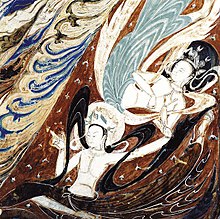| Dunhuang dance | |||||||
|---|---|---|---|---|---|---|---|
 Dunhuang mural flying apsarasa Dunhuang mural flying apsarasa | |||||||
| Chinese | 敦煌舞 | ||||||
| Literal meaning | Dunhuang dance | ||||||
| |||||||
Dunhuang Dance is a form of Chinese dance which combines traditional culture and modern art. Dunhuang dance draws inspiration from the body movements in the Dunhuang grotto frescoes (such as in the Mogao caves), and the musical instruments and music scores found in Dunhuang, Gansu province, West China. The dance shows the combination of ethnic dance styles from Central and Western China. The dance, itself, is also influenced by Buddhist images and Buddhism.
Sources of inspiration
The Mogao grottoes in Dunhuang houses several form of fine arts such as dance and music. It is filled with many dance images which inspired modern dance artists in China. Images of flying apsaras (Feitian) from the grottoes are also a source of inspiration.
List of Dunhuang dances
Thousand Hand Guan Yin
It is a contemporary creation produced by the Chinese choreographer Zhang Jigang. It was performed by the China Disabled Performing Art Troupe in which the group dancers are hearing-impaired.
-
 Modern choreography Thousand hand Guanyin
Modern choreography Thousand hand Guanyin
Other depictions in media
- Rain of Flowers Along the Silk Road, a dance drama presented in Beijing on May 23, 1979 by the Gansu Dunhuang Art Academy of China.
Gallery
-
 Dunhuang dance
Dunhuang dance
-
 A pipa player playing with the pipa behind his back. Dunhuang, Mogao Caves.
A pipa player playing with the pipa behind his back. Dunhuang, Mogao Caves.
-
 China, mid-Tang Dynasty. Artwork from the Dunhuang Grottos, Yulin Cave number 25 showing a Bird of Life, playing a pipa, with a dancer playing drum
China, mid-Tang Dynasty. Artwork from the Dunhuang Grottos, Yulin Cave number 25 showing a Bird of Life, playing a pipa, with a dancer playing drum
-
 Buddhist cave art, a dancer spins while the orchestra plays. Grotto 46 Left interior wall, second panel. Also called cave 112.
Buddhist cave art, a dancer spins while the orchestra plays. Grotto 46 Left interior wall, second panel. Also called cave 112.
-
 Cave 220 “Hu xuan” dancer in mural from Mogao.
Cave 220 “Hu xuan” dancer in mural from Mogao.
See also
References
- ^ Yang, Jia (2017). "Analysis on Cultural Characteristics and Art Development of Dunhuang Dance Art". Proceedings of the 2nd International Conference on Contemporary Education, Social Sciences and Humanities (ICCESSH 2017). Paris, France: Atlantis Press. doi:10.2991/iccessh-17.2017.110. ISBN 978-94-6252-351-7.
- Shahshahānī, Suhaylā (2004). Body as medium of meaning. LIT Verlag. pp. 72–86. ISBN 978-3-8258-7154-3.
- ^ The heritage of Chinese culture and dance. Classical dance : Dunhuang. Ming Chen; Sandra Parks; Jake McNeill; Stella Xu; Kennesaw State University. 2016. OCLC 964534193. Archived from the original on 2021-12-25 – via Worldcat.
{{cite book}}: CS1 maint: others (link) - "A DANCE OF DUNHUANG". www.esplanade.com. 2021. Retrieved 2021-12-25.
- ^ "Dance Drama Celebrates Dunhuang Culture". en.chinaculture.org. Retrieved 2021-12-25.